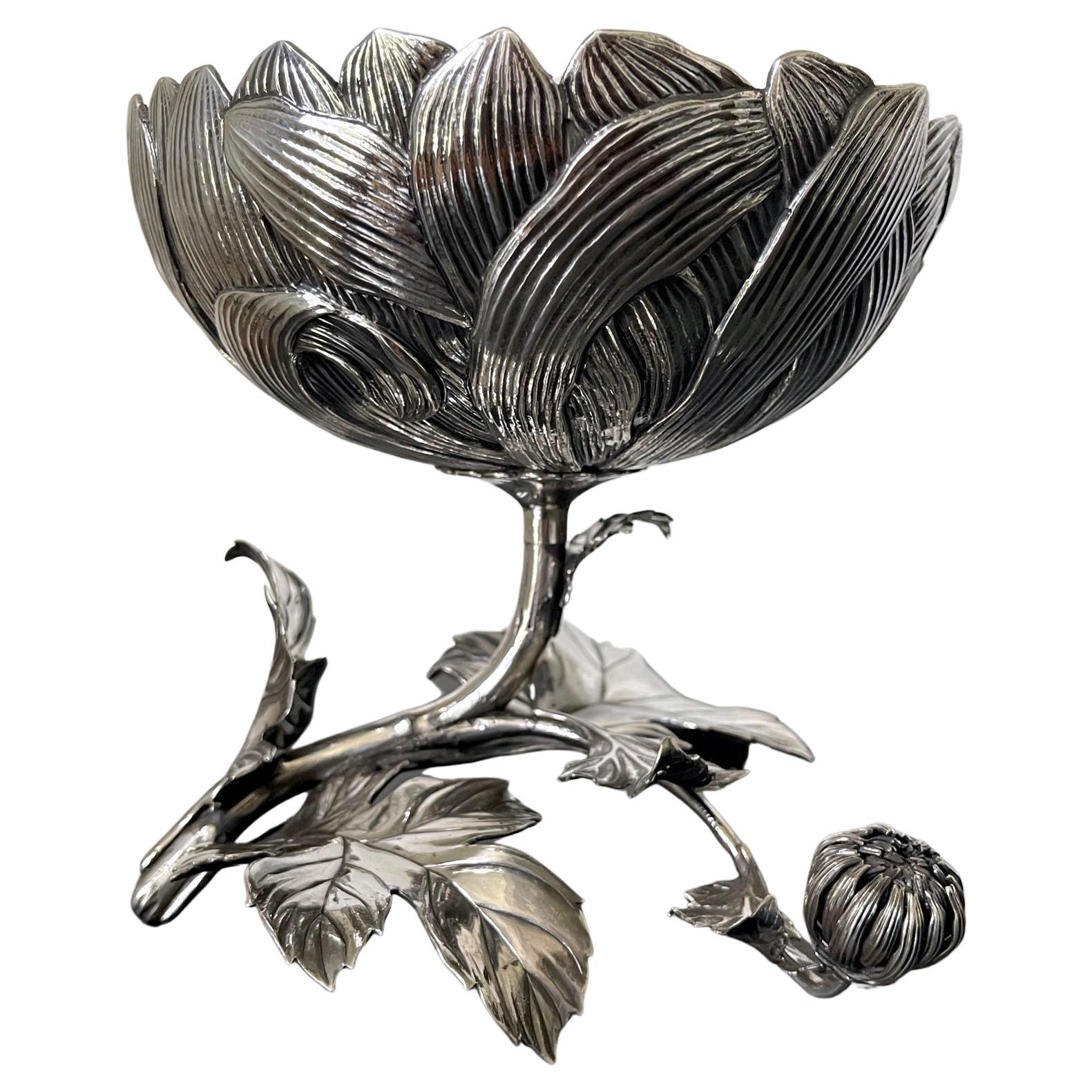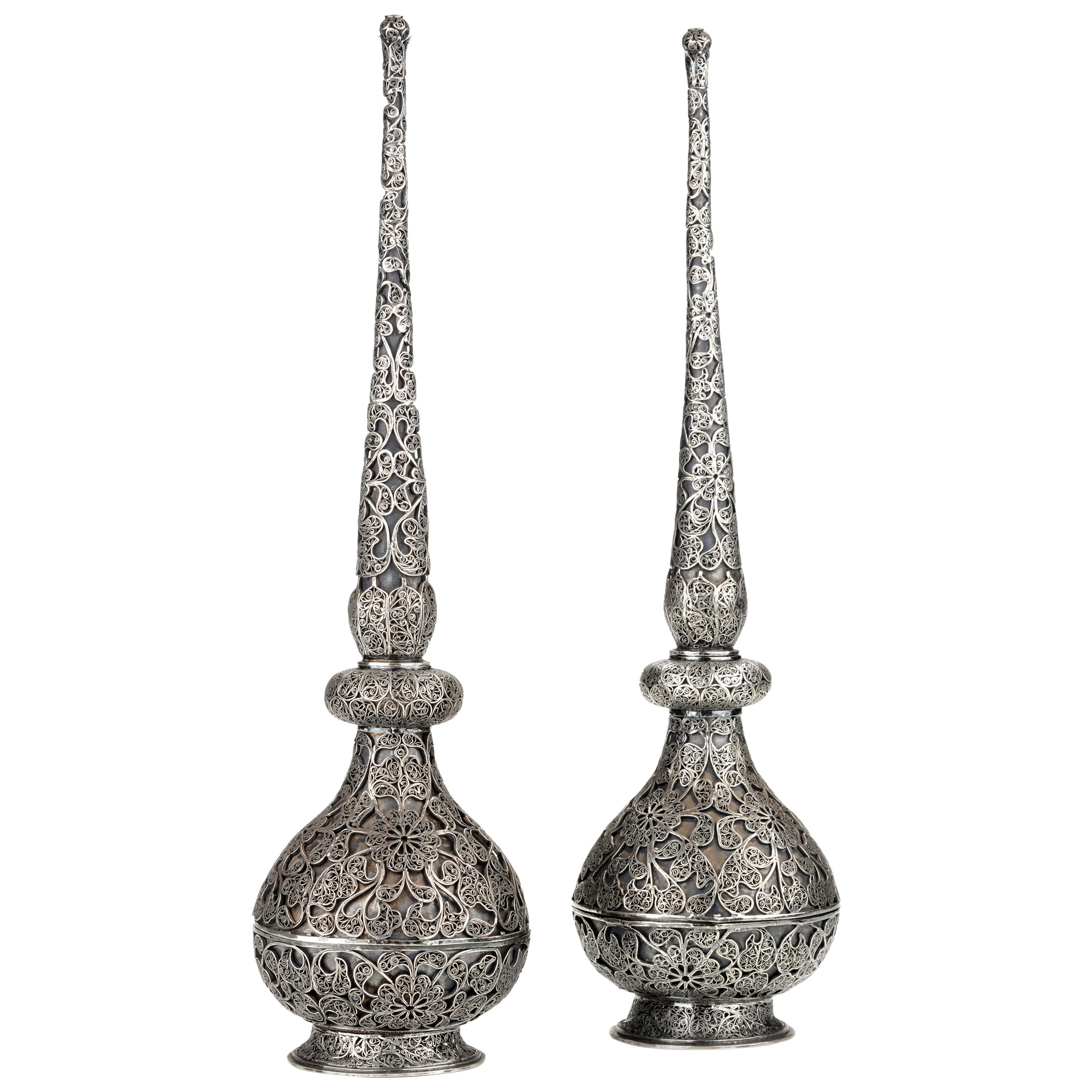Items Similar to Dutch Colonial Silver Dish with the Von Pfeffel Coat-of-arms, 17th Century
Want more images or videos?
Request additional images or videos from the seller
1 of 2
Dutch Colonial Silver Dish with the Von Pfeffel Coat-of-arms, 17th Century
About the Item
An unusual Indonesian lobbed silver dish
Jakarta (Batavia) or Coromandel coast, third quarter 17th century, apparently unmarked
The eight lobbed dish exuberantly decorated with floral motifs, with the middle section replaced, consisting of indistinctly marked German silver from the early 19th century, bearing the coat-of-arms of the Von Pfeffel family.
Diam. 30.5 cm
Weight 461 grams
Note:
Lobbed silver dishes with exuberant floral decorations were characteristic of the decorative arts in the Netherlands in the first half of the 17th century. This style of floral decoration was adopted by silversmiths as well as by furniture makers working on the Coromandel Coast and in Batavia, often by workers who had fled the Coromandel Coast because of war and famine. In Batavia this style was known as “Custwerck” (work from the Bengal coast).
These lobbed dishes are seldom marked. Only after 1667 the use of the town mark became obligatory in Batavia but only for silver made in Batavia not for silver imported in Batavia from other VOC settlements. The engraved coat of arms in the centre is a replacement of the original centre.
The coat of arms can be identified as those of Christian Hubert von Pfeffel (1765- 1834). As a diplomat, statesman, ambassador of Bavaria in London and Saxony and councillor to the King of Bavaria, he was made “Freiherr” in 1828 and since then used this coat of arms. His son Karl Maximilian Friederich Hubert Freiherr von Pfeffel (1811-1890) in 1836 married Karoline Adelheid Pauline von Rottenburg (1805-1872), the natural daughter of Prins Paul von Württemberg (1785-1852) and his mistress Margrethe Porth. Paul was the jounger brother of the King Wilhelm I of Württemberg (1781-1864). The heraldic motto of the von Pfeffels Vur Schande habe den Huot means as much as “Beware of Shame”. Christian Hubert Theodoor Marie Karl von Pfeffel Karl Maximilian’s grandson was the last male in the von Pfeffel line. His daughter, Marie Louise (Paris in 1882 - Cornwall 1944), born and grown-up in France, changed her name in de Pfeffel. She was the great grandmother of Boris Alexander de Pfeffel Johnson, the present British Secretary of State. None of the members of the von Pfeffel family had any direct links with the Dutch East Indies but indirectly by way of the Royal House of Württemberg they did.
Sophia Frederika Mathilda von Württemberg (1818-1877), daughter of Wilhelm I King of Württemberg, in 1839 married Willem III of the Netherlands and was Queen from 1849 till her death in 1877. The marriage was a disaster; Willem, known in Holland as “King Gorilla”, had many affairs and Sophie, being intellectually far his superior with much interest in art and culture, was a bit of a hysteric. Sophie was a niece of Prins Paul von Würtemberg and therefore a full cousin of Karoline von Pfeffel, the natural daughter of Paul von Württemberg. Karoline and Sophie were good friends.
In the collection of the Gemeente Museum Den Haag is a beautiful lobbed dish with a border of irrefutable late 17th century oriental origin but with an inserted European silver plaque in the centre showing Queen Sheba’s visit to King Solomon. The maker of this plaque must be sought in the circles around the Augsburg silversmith Johann Andreas Thelot (1655-1734). Although the dish and plaque date from around the same time they have been put together only in the late 19th century. In the late 19th century it was certainly not uncommon to make counterfeits of this kind to “improve”on things from the past, as these two examples show (Silver from Batavia, Titus Eliëns, Gemeentemuseum Den Haag, ill. 4).
- Dimensions:Height: 1.58 in (4 cm)Diameter: 12.01 in (30.5 cm)
- Style:Dutch Colonial (Of the Period)
- Materials and Techniques:
- Place of Origin:
- Period:Late 17th Century
- Date of Manufacture:1675-1700
- Condition:Wear consistent with age and use.
- Seller Location:Amsterdam, NL
- Reference Number:1stDibs: LU5458220976442
About the Seller
5.0
Vetted Seller
These experienced sellers undergo a comprehensive evaluation by our team of in-house experts.
Established in 1985
1stDibs seller since 2020
Typical response time: 2 hours
- ShippingRetrieving quote...Ships From: Amsterdam, Netherlands
- Return PolicyA return for this item may be initiated within 7 days of delivery.
More From This SellerView All
- Splendid and Heavy Late 17th Century Dutch-Colonial Silver Filigree SalverLocated in Amsterdam, NLA splendid and heavy Dutch-colonial silver filigree salver Indonesia, Batavia (Jakarta) or possibly Padang, West Sumatra, 2nd half 17th century Diam. 22.9 cm Weight 551 grams This filigree-work was probably done by Chinese masters...Category
Antique 17th Century Indonesian Dutch Colonial Metalwork
MaterialsSilver
- Fine 17th Century Dutch Colonial Armorial Tortoiseshell & Silver Box, Dated 1691Located in Amsterdam, NLA dutch tortoiseshell box with two engraved silver plaques Amsterdam, 1691, with maker's mark of Steven des Rousseaux (1654-1733) H. 5 cm Diam. 12.5 cm Note: Steven des ...Category
Antique 17th Century Dutch Sterling Silver
MaterialsSterling Silver
- Pair of Fine Islamic Silver Filigree Rosewater Sprinklers, Early 18th CenturyLocated in Amsterdam, NLA pair of very fine silver filigree rosewater sprinklers Possibly India, Karimnagar, early 18th century Height 31.6 cm and 31.7 cm, weight 39...Category
Antique Early 18th Century Indian Islamic Metalwork
MaterialsSilver
- A 17th century Dutch-colonial ebony two-door VOC cabinet with silver mountsLocated in Amsterdam, NLA Dutch-colonial ebony two-door cabinet with silver mounts Coromandel Coast, probably Masulipatnam, circa 1650-1680, the silver later H. 64.5 x W. 75 x D. 46 cm The present cabinet...Category
Antique 17th Century Indian Dutch Colonial Antiquities
MaterialsSilver
- Dutch Colonial 17th Century Ebony Center Table with Marble TopLocated in Amsterdam, NLAn Indonesian ebony centre table with marble top Jakarta (Batavia) or Coromandel coast, 1650-1680 With shallow carvings of flowers and vi...Category
Antique Mid-17th Century Indian Dutch Colonial Furniture
MaterialsMarble
- A Dutch Colonial 17th century Red Ebony Center table with marble topLocated in Amsterdam, NLA MOLUCCAN RED EBONY CENTRE TABLE WITH MARBLE TOP The Moluccas/Ambon, third quarter 17th century Carved in low-relief with decoration of plant...Category
Antique Late 17th Century Indian Dutch Colonial Furniture
MaterialsMarble
You May Also Like
- Seal Silver Coat of Arms 17 CenturyLocated in BUNGAY, SUFFOLKThere is no letter date demonstrating that this seal was made before 1697 when the letter date became mandatory. This seal is an early shape, engraved with the owners coat of arms. ...Category
Antique 17th Century English Baroque Sterling Silver
MaterialsSilver, Britannia Standard Silver
- Japanese Sterling Silver Chrysanthemum Dish Meiji PeriodBy MusashiyaLocated in Atlanta, GAAn exquisite Japanese sterling silver ornamental bonbon dish, circa 1890-1900. The piece was rendered in the shape of a stemmed branch of chrysanthemum blossom and was made for export market. Both botanically realistic and stylish, the piece showcases a high degree of artisanal sensitivity and technical ability of the silversmith who created this lovely piece. The petals that form the exteriors were outlined with deep and fluid relief lines of sculptural quality. The branches and leaves were rendered with attentions to the smallest details, with molding and surface texturizing using chasing in contrast with hammering. The interior of the dish is equipped with a conforming inner dish and when it is taken out, revealing the chased lines. The piece, although practical, is basically an okimono in sculptural form, a work of art on its own. It weighs about 22 ounces. Under the dish, it is marked "Pure Silver" in Kanji and SM in a rectangular cartouche. The research (carried out by Adrien Von Ferscht, an expert and author on Asian Export Silver) identified it to be Sadajiro Musashiya...Category
Antique 1890s Japanese Japonisme Metalwork
MaterialsSterling Silver
- Peranakan Chinese Export Silver Tankard with Dragon Handle, 19th CenturyLocated in Austin, TXA heavy and well cast Chinese export silver tankard with a dragon handle, made of the Southeast Asian market, mid-late 19th century, China. The double walled mug or tankard featur...Category
Antique Late 19th Century Chinese Chinese Export Sterling Silver
MaterialsSilver
- Pair of Contemporary Silver Earrings "Na Linii" Handcrafted with Natural PearlsBy Artem Zakharchenko-HalytskyiLocated in Vilnius, LTNa Linii earrings by Svitanok This Ukrainian origin word "Na Linii" means "on the line". It is a charismatic product that should not be perceived literally...Category
2010s Ukrainian Minimalist Metalwork
MaterialsSterling Silver
- Chinese Export Silver Tankard by Luen Hing, Early 20th Century, ChinaLocated in Austin, TXA wonderful Chinese export silver bamboo motif tankard by Luen Hing, circa 1920, Shanghai, China. The large tankard with a slightly bulgi...Category
Early 20th Century Sterling Silver
MaterialsSilver
- Chinese Export Silver Sugar Tongs by Luen Wo, Early 20th Century, ChinaLocated in Austin, TXA wonderful pair of Chinese export silver small sugar tongs in a bamboo pattern by Luen Wo, late 19th or early 20th century, Shanghai, China. The small silver tongs wonderfully cr...Category
Early 20th Century Chinese Chinese Export Metalwork
MaterialsSilver
Recently Viewed
View AllMore Ways To Browse
Colonial Dutch
Holland House Antique Furniture
Colonial Furniture Dutch
19th Century British Colonial Furniture
De Von
Dutch 1890
17th King
Holland And Sons Furniture
Holland And Sons
Holland And Son
Antique Colonial Kitchen
17th Century Dutch Style
Silver Indonesia
Art Glass Plaque
Indonesian Dutch
Dutch Indonesia
Antique Colonial House
Late 19th Century Secretary





